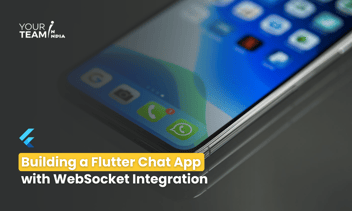Quick Summary: This comprehensive guide explores the seamless integration of APIs with Flutter. Learn how to leverage Flutter's flexibility and versatility to connect and interact with various APIs, enabling dynamic data retrieval and powerful functionality in your applications.
Introduction
Flutter, Google's UI toolkit for building natively compiled applications for mobile, web, and desktop from a single codebase, becomes even more powerful when combined with APIs (Application Programming Interfaces). In this comprehensive guide, we'll explore the integration of APIs with Flutter, covering the basics, common patterns, and best practices to create dynamic and data-driven mobile applications.
Understanding APIs and Their Role in Flutter
What is an API?
An API, or Application Programming Interface, serves as a bridge between different software systems, enabling them to communicate and interact. In the context of mobile app development, APIs allow Flutter applications to retrieve, send, and manipulate data from external sources such as servers, databases, or third-party services.
The Role of APIs in Flutter
Integrating APIs with Flutter is crucial for creating dynamic and data-driven applications. APIs provide a way for Flutter apps to fetch real-time data, authenticate users, and perform various tasks without the need for local databases or hardcoded content.
Types of APIs in Flutter
There are various types of APIs that Flutter apps commonly interact with:
- RESTful APIs: Representational State Transfer (REST) APIs use standard HTTP methods (GET, POST, PUT, DELETE) for communication. They are widely adopted due to their simplicity and scalability.
- GraphQL APIs: GraphQL is an alternative to REST, allowing clients to request only the data they need. Flutter applications can efficiently retrieve and update data using GraphQL APIs.
- Third-Party APIs: Many services offer APIs for developers to integrate features into their apps. Examples include social media APIs (e.g., Twitter, Facebook), payment gateways (e.g., Stripe), and mapping services (e.g., Google Maps).
Integrating APIs with Flutter
Making HTTP Requests
Flutter provides the `http` package to make HTTP requests. Below is a simple example of fetching data from a RESTful API:
```dart
import 'package:http/http.dart' as http;
import 'dart:convert';
Future<void> fetchData() async {
final response = await http.get(Uri.parse('https://api.example.com/data'));
if (response.statusCode == 200) {
// Parse the JSON response
final Map<String, dynamic> data = json.decode(response.body);
print('Received data: $data');
} else {
// Handle error
print('Failed to fetch data. Status code: ${response.statusCode}');
}
}
```
Decoding JSON Responses
APIs often return data in JSON format. Flutter provides a `dart:convert` package to encode and decode JSON. In the example above, `json.decode()` is used to parse the JSON response.
Handling API Responses
It's essential to handle API responses gracefully, considering potential errors or network issues. Flutter's `async/await` pattern helps manage asynchronous operations when fetching data.
```dart
try {
await fetchData();
} catch (error) {
print('Error fetching data: $error');
}
```
State Management for API Integration
State management is crucial when dealing with APIs. Flutter offers various state management solutions (e.g., Provider, Riverpod, Bloc) to manage UI states, loading indicators, and data updates efficiently.
Best Practices for API Integration in Flutter
- Use Dart's `async/await`: Embrace Dart's asynchronous programming features to handle API calls seamlessly without blocking the UI.
- Error Handling: Implement robust error handling mechanisms to gracefully manage API errors, network issues, or unexpected responses.
- Secure API Keys: When using APIs that require authentication, store sensitive information such as API keys securely. Flutter provides solutions like `flutter_dotenv` for managing environment variables.
- State Management: Based on your app's complexity, Choose an appropriate state management solution. This ensures a scalable and maintainable codebase.
- Optimizing API Calls: Minimize unnecessary API calls by caching data when appropriate and implementing smart fetching strategies to update data only when necessary.
- Testing: Write unit tests for your API calls to ensure they behave as expected. Mocking tools like `http_mock` can be helpful for testing API interactions.
Conclusion
Integrating APIs with Flutter opens the door to dynamic and feature-rich mobile applications. Whether you're fetching data from a RESTful API, using GraphQL, or leveraging third-party services, Flutter's flexibility and diverse ecosystem make API integration a smooth and efficient process.
By following best practices, handling errors gracefully, and incorporating robust state management, you can create Flutter applications that seamlessly interact with external APIs. This synergy between Flutter and APIs empowers developers to build responsive and data-driven mobile experiences across different platforms.
Hire Flutter developers to elevate your Flutter app design. Unlock the full potential of Flutter layouts with our professional Flutter developers.








